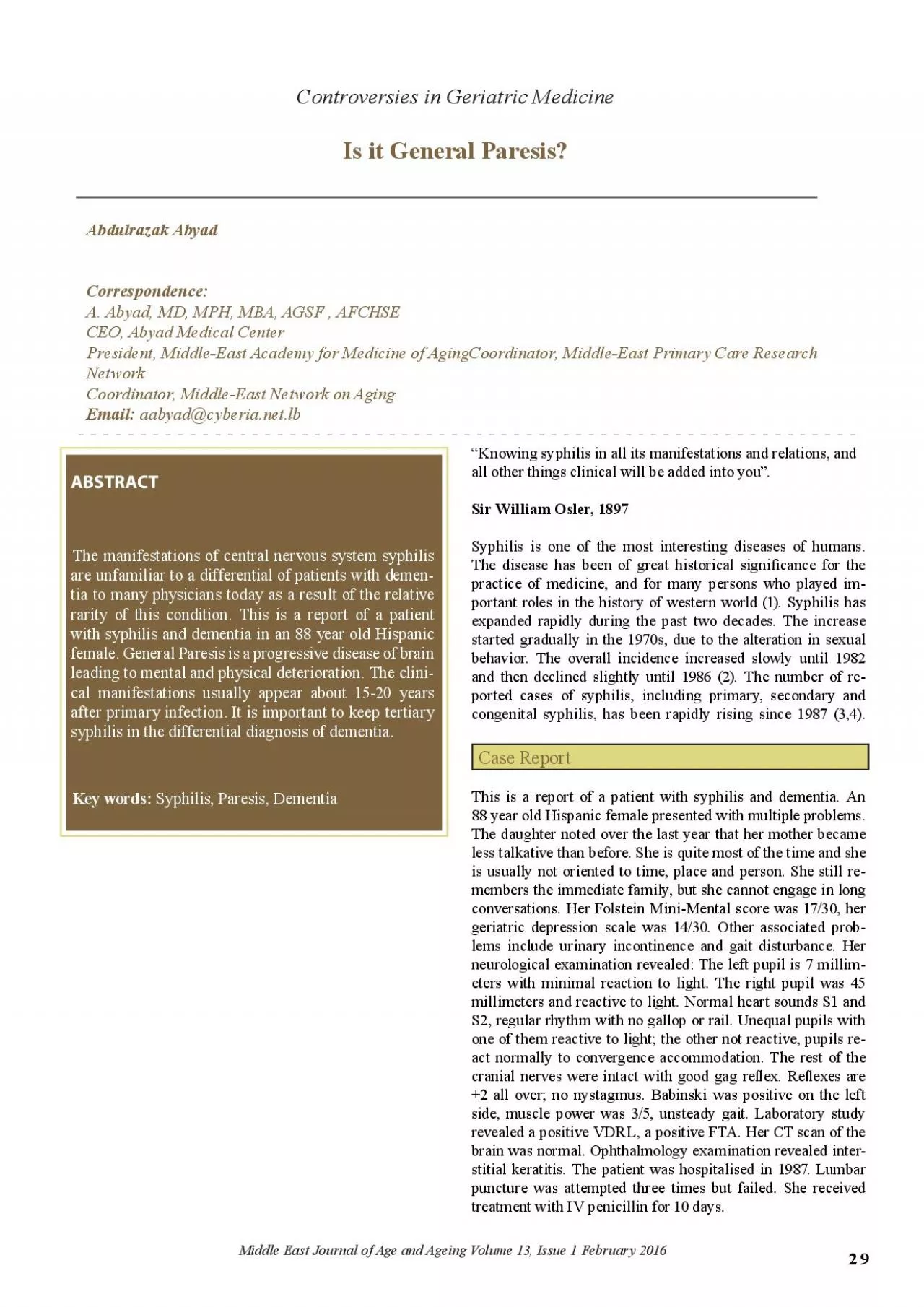

Correspondence A Abyad MD MPH MBA AGSF AFCHSE CEO Abyad Medical Center President MiddleEast Academy for Medicine of AgingCoordinator MiddleEast Primary Care Research Network Coordinator ID: 958483
Download Pdf The PPT/PDF document "________________________________________..." is the property of its rightful owner. Permission is granted to download and print the materials on this web site for personal, non-commercial use only, and to display it on your personal computer provided you do not modify the materials and that you retain all copyright notices contained in the materials. By downloading content from our website, you accept the terms of this agreement.
_____________________________________________________ Abdulrazak Abyad Correspondence: A. Abyad, MD, MPH, MBA, AGSF , AFCHSE CEO, Abyad Medical Center President, Middle-East Academy for Medicine of AgingCoordinator, Middle-East Primary Care Research Network Coordinator, Middle-East Network on Aging Email: aabyad@cyberia.net.lb ABSTRACT 88 year old Hispanic female presented with multiple problems. The daughter noted over the last year that her mother became less talkative than before. She is quite most of the time and she is usually not oriented to time, place and person. She still re - members the immediate family, but she cannot engage in long conversations. Her Folstein Mini-Mental score was 17/30, her geriatric depression scale was 14/30. Other associated prob - lems include urinary incontinence and gait distu
rbance. Her side, muscle power was 3/5, unsteady gait. Laboratory study revealed a positive VDRL, a positive FTA. Her CT scan of the brain was normal. Ophthalmology examination revealed inter - stitial keratitis. The patient was hospitalised in 1987. Lumbar puncture was attempted three times but failed. She received treatment with IV penicillin for 10 days. 33 Middle East Journal of Age and Ageing 2009; Volume 6, Issue 5 Middle East Journal of Age and Ageing Volume 7, Issue 5, November 2010 Middle East Journal of Age and Ageing Volume 7, Issue 5, November 2011 Middle East Journal of Age and Ageing Volume 13, Issue 1 February 2016 Diagnosis and Differential Diagnosis The clinical picture, is easily distinguishable in its full-blown form, however is more hard to ascertain when atypical or in - complete. Spinal �u
id alterations usually help in the diagnosis. The CSF is abnormal in all untreated cases of general paresis, but the same alterations can happen in the middle of other neu - rosyphilis. Hence, the association of preexisting CSF alterations of asymptomatic syphilitic meningitis with a diversity of or - ganic brain syndromes can be misdiagnosed as general pare - sis. These include cerebral tumor, subdural hematoma, cerebral arteriosclerosis, Alzheimer’s disease, multiple sclerosis, senile dementia, and chronic alcoholism. CT scan �ndings, the pres - ence of pupillary changes, and a history of drug or alcohol abuse are useful in accurate diagnosis. Hallucinations are important in delirium tremens but are unusual in general paresis. How - ever alcoholic worsening and Korsakoff’s psychosis can present a
picture of memory loss, unsuitable conduct, mood swings, and faulty opinion that is hard to differentiate from paresis. An adult-onset seizure disorder can be a presentation of paresis or of an exceptional form of neurosyphilis. Paresis may be ruled out when CSF irregularities are lacking. When CSF alterations of neurosyphilis are present, the inquest change to whether the seizures symbolize epilepsy in a patient with asymptomatic neurosyphilis or whether they are the presentations of syphilitic brain injury. The presence of focal neurologic �ndings in pa - tients with neurosyphilis-produced seizures aids in answering the question. Management ANTIBIOTIC THERAPY The management of neurosyphilis and outcome has markedly improved since the introduction of penicillin. In a multicenter study including treatment o
f over 1000 patients with paresis, a total penicillin dosage of six million units was judged to be satisfactory (23). Patients who required re-treatment to arrest the infection had received less than six million units of peni - cillin initially. In the past decade it has been recognized that the treatment with 7.2 million units of benzathine penicillin G (2.4 million units intramuscularly weekly for 3 doses) is suf - �cient treatment for all kinds of neurosyphilis. The most re - cent recommendations of the Centers of Disease Control (24) involve the use of either intraveneous aqueous penicillin G for 10 days, intramuscular procaine penicillin G for 10 days, or weekly injections of benzathine penicillin G for 3 doses (Table 4) (24). Intravenous penicillin G for 10 to 15 days is the most reasonable therapy to
employ for symptomatic or asymptomatic neurosyphilis. This assures penicillin concentrations in CSF which are continuously at least several fold above the minimally treponimicidal concentration of 0.018 microgram per milliliter during therapy (25, 26). Alternatively, daily aqueous procaine penicillin G (plus probenecid) for 10 to 14 days would be prefer - able to benzathine penicillin G, that is no longer recommended by the World Health Organization. FOLLOW-UP AND RE-TREATMENT The CSF data are normally a reliable index of the activity of neurosyphilis and furnish a gauge of the ef�cacy of the antibi - otic therapy. When initial penicillin therapy has stopped the in - fection, repeat CSF examination at 3 to 6 months reveals normal cell count and, if initially elevated, a decline in concentration of protein (